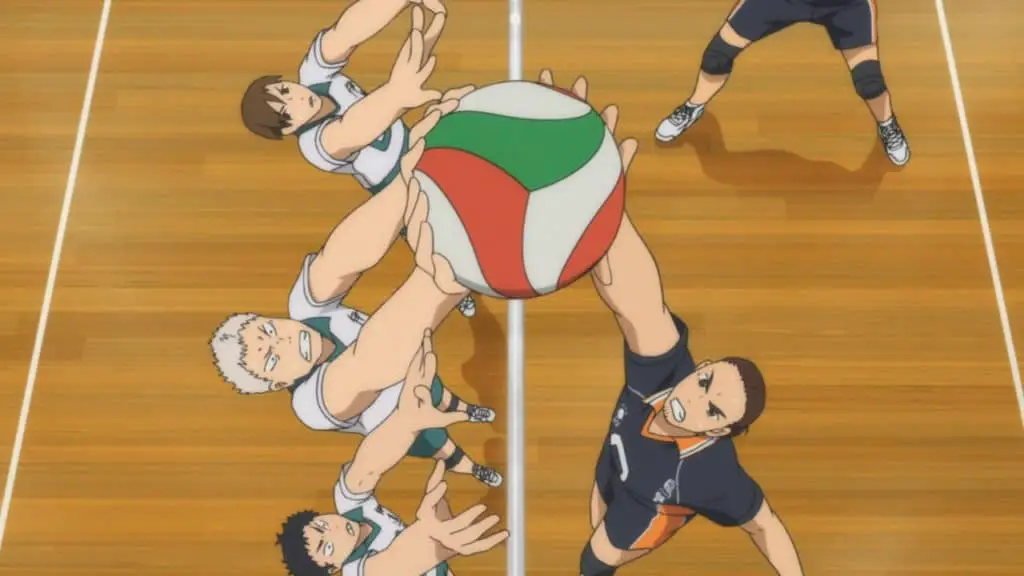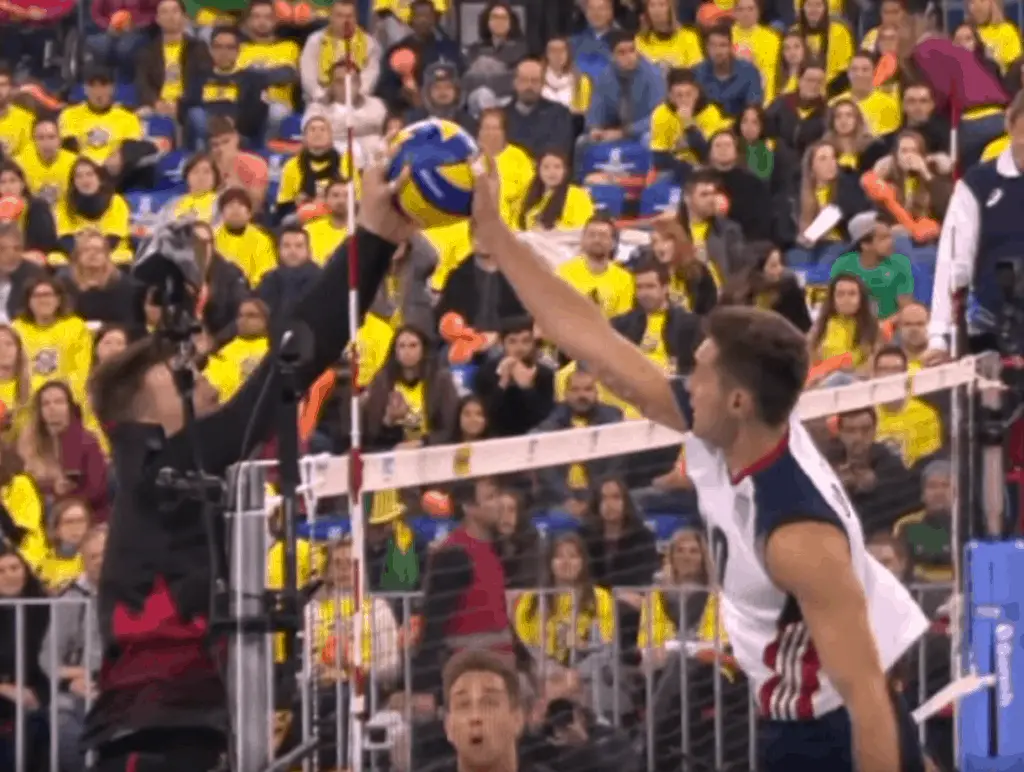
You are a setter. Your teammate just received the service, and it’s a little high and tight to the net. You’re thinking of dumping the ball over the net. You jump for the ball and try to push it down on the other side when suddenly your opponent jumps to block and strongly pushes back on the ball. What should you do? Too late, you just lost the point because of your indecisiveness. What just happened? You just lost a joust.
In volleyball, a joust refers to a situation where two opposing players simultaneously make contact with the ball above the net resulting in prolonged contacts by both players. In this event, both players attempt to push the ball on the opposing side of the court to end the rally.
Typically, a joust happens only in specific situations where the ball would land on the net or very close to it. It is a very niche scenario but we know how useful it is to be prepared for anything when playing volleyball. In the rest of this article, I’ll go over the known strategies on how to win a joust, the rules to know about when jousting and some practice drills to help you get better.
What is a joust
I would like to expand on my definition of a joust. A joust requires that both players contact the ball at the same time and that it stalls between their hands. Jousting in volleyball should happen when the ball would land over the centerline of the net where each side could technically play the ball. Letting an opponent get to a ball above the net uncontested will likely result in a lost point, which is exactly why a joust is the best course of action.
An important thing to know about jousts in volleyball is that there are general rules around it. For a joust to occur within the rules of volleyball, the ball needs to be falling directly above the centerline of the net. If the ball leans more on one side and an opposing blocker reaches for the ball and crosses the vertical plane of the net, a referee could call that a “Reach” over the net. This would result in a lost point for that player. Further down in this article, I’ll go over more of the known volleyball rules concerning jousting.
How to win a joust
There are many scenarios where a joust can happen. Fortunately, there seems to always be a strategy available to a player for them to win a joust. All that a player needs is to be able to recognize which is appropriate for which scenario.
When it comes to jousting in volleyball, there are 3 prominent strategies that can be used. Let’s break them down individually below.
Contact the Ball First and Redirect Away
In most circumstances, getting to the ball first offers a real advantage where you can push down and try to make the opposing player lose their grasp of the ball by redirecting it away from them. When you are around the middle of the court, this strategy can be really effective. The key is to focus your effort on pushing in a direction and not just holding the ball on the other side.
Contact the Ball Second, Get Under and Block
If you get to the ball second, consider this strategy. Many would consider this strategy to be the most efficient. You can sometimes try to slow down your contact with the ball to try this strategy. By being second, a player can get under the ball and block any attempt at redirecting or pushing down as well as hang onto the ball longer. As soon as the other player lets go of the ball, that is the time to push the ball through their side of the net.

Wiping the Ball Away
This strategy is again very strong and should be a priority whenever close to the outside lines of the court. Winning a joust does not guarantee a point, but this strategy almost always does.
Wiping the ball outside the court is a strategy often used by outside hitters when they only have one hand on the ball against one or two blockers. In this scenario it is important to capitalize on the strength of one arm were the player has to swipe the ball off the blockers’ hands. For it to work, the hitter must do everything to give a sideways momentum on the ball, giving it the push it needs to go out of bounds.
Recognizing When a Joust Will Happen
Hopefully, I have now made it clear what a joust is in volleyball but I still have some more information to share that could help you recognize when a joust is likely to happen.
A joust can happen between any players at the net. Although that’s true, there are some common scenarios will lead to a joust. All players should, on average, equally be involved in jousts when defending. That being said, on the offense, setters will usually get more reps at a joust. The reason is that setters should be prepared to set the ball, positioned close to the net, while their teammates should be prepared to make their approach to hit.
Even though that is the case, it can be very helpful to recognize when a joust will happen. All volleyball players know that many things can go wrong in a single point and that it is important to be ready for anything. Every member of the team should be alert and ready to act at all times, so what should you do when a joust happens?
When a player jumps for a joust, the rest of the team should be immediately trying to cover around the player. It is important to be aware of the possibility that your player loses the joust, but that does not automatically lose the point, you can still dig the ball up and keep the rally going.
For example, a common scenario could be the one I mentioned in the introduction where the ball is passed tightly to the net or over the setter. The setter and the opposing hitter would likely enter a joust. The opposing hitter could be a middle, opposite hitter or outside hitter.
Another common scenario for a joust is in the event of a setter setting the ball too rapidly and on top of the net. An experienced hitter should recognize this event as one likely to cause a joust against the opposing blockers.
Rules of Jousting in Volleyball
Before I end this article, here’s what you need to know surrounding the rules of jousting in volleyball.
Rules of the FIVB address the joust specifically in section 9.1.2.3. It reads “If simultaneous hits by two opponents over the net lead to an extended contact with the ball, play continues”.
A common question related to jousting is if it counts as one of the three allowed contact. Section 9.1.2.2 of the FIVB rulebook state “When two opponents touch the ball simultaneously over the net and the ball remains in play, the team receiving the ball is entitled to another three hits. If such a ball goes “out”, it is the fault of the team on the opposite side.”
A very rare situation within a joust needs a specific ruling which is if two players are still touching the ball and it touches an antenna, a replay will be indicated.
You can read more on the rules directly from the FIVB rulebook here. Some other rules could exist within specific leagues, but generally organized forms of volleyball will base its rules on the FIVB rulebook.
Practicing your jousting
Now that you’ve read all this information, its time to put your knowledge to good use and practice. Here are some drills I would suggest:
- This drill can be done with 2 players, no net required. One player simply holds the ball and have the second player press against it. This drill will help you to understand how to push against something that can be unstable. You can also have this drill with a net and have one player standing on a box/platform where they will hold a ball above the net. The second player will jump and try to press and disrupt the ball from the other player’s hands.
- The second drill requires two players and another person. Two players face each other at the net and wait for the ball. A third person will throw the ball above the net and have the two players joust for the ball.
- This drill incorporates the joust and focuses on a game scenario. This would be a repeat of drill number two while adding a whole team. The goal is to play the ball out and try to keep it alive when a joust happens.
When practicing, remember to learn from each repetition and to try to work on your technique every time. Practicing is your opportunity to define how you will confront this situation in a game scenario. Some make mistakes but learn from them.
Conclusion
In conclusion, the joust is an important tool to learn as a volleyball player. Being the sport that it is, volleyball is all about being ready to react to everything the game and your opponents throw at you. The joust is one skill that will elevate your game and help you be prepared.
